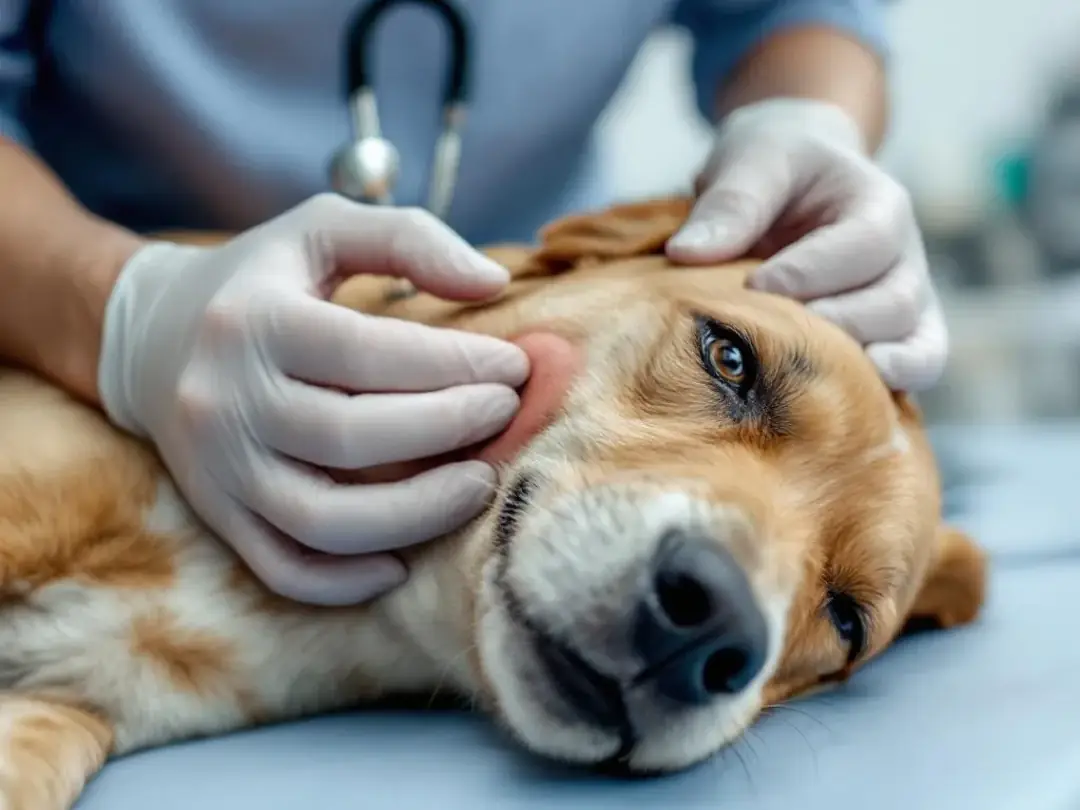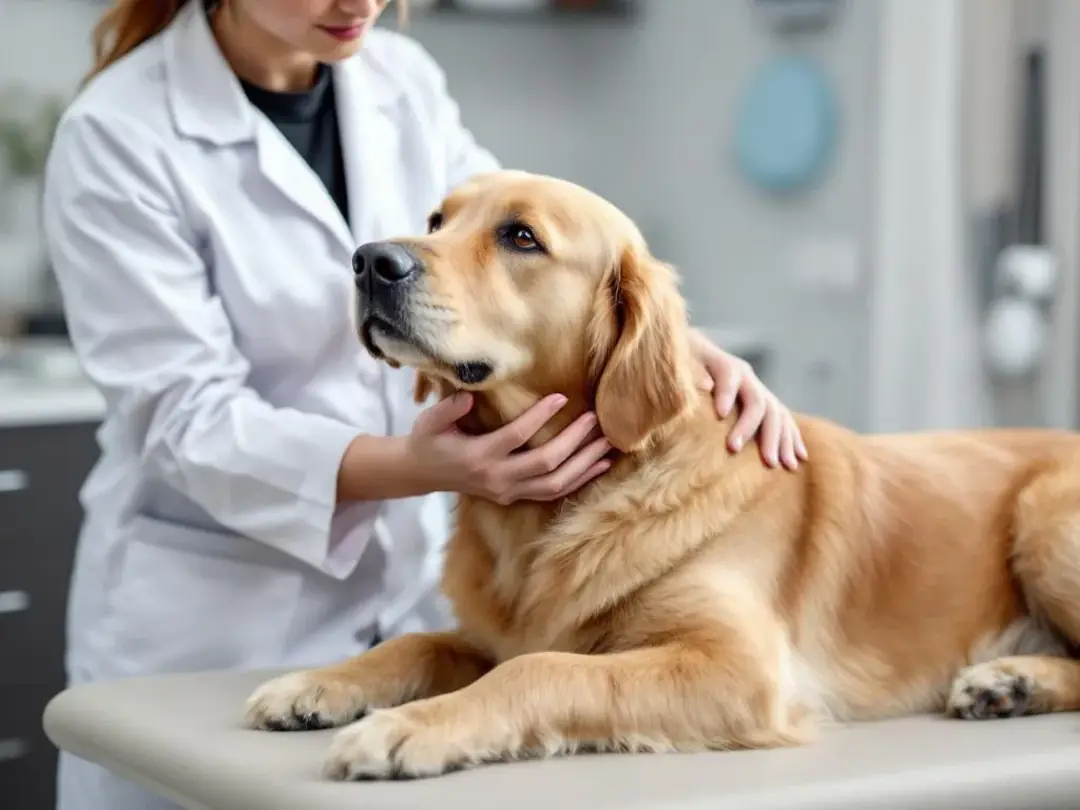Key Takeaways
-
Lymphoma is the most common cancer in dogs, affecting 15-20% of all canine cancer cases and primarily targeting the lymphatic system including lymph nodes, spleen, and bone marrow
-
Four main types exist: multicentric (80-85% of cases), alimentary, mediastinal, and extranodal, each presenting with different symptoms and locations
-
Early signs include enlarged lymph nodes (especially under chin and behind legs), weight loss, lethargy, and decreased appetite, though symptoms vary by lymphoma type
-
Chemotherapy is the primary treatment achieving remission in 80-85% of dogs, with average survival extending from 4-6 weeks untreated to 8-12 months with treatment
-
While lymphoma cannot be cured, it can be managed effectively, allowing dogs to maintain good quality of life during treatment and remission periods
What is Lymphoma in Dogs?
Lymphoma in dogs is a malignant cancer that affects lymphocytes, which are specialized white blood cells that play a crucial role in your dog's immune system. Lymphoma can arise from either B cells or T cells, and the type of cell involved influences the disease's behavior, presentation, and classification. Unlike many other cancers that form solid tumors in specific organs, lymphoma typically spreads throughout the lymphatic system, affecting multiple areas of your dog's body simultaneously.
The lymphatic system serves as your dog's internal defense network, consisting of lymph nodes, lymph vessels, the spleen, tonsils, and bone marrow. This intricate system helps filter harmful substances, produces white blood cells, and maintains fluid balance throughout the body. When lymphoma develops, cancer cells multiply rapidly within lymphoid organs, disrupting normal immune function and potentially affecting other body systems. The organs affected can include the spleen, liver, and other non-lymphatic organs, depending on the lymphoma type.
Veterinary professionals sometimes refer to this condition as lymphosarcoma (LSA), but both terms describe the same disease. What makes lymphoma particularly challenging is its systemic nature-by the time clinical signs become apparent, the disease has often already spread to multiple lymph nodes or organs.
Statistical data shows that lymphoma accounts for approximately 7-24% of all canine cancers, with certain breeds showing genetic predisposition to develop this condition. The disease typically affects middle-aged to older dogs, with a median age at diagnosis between 6-9 years, though it can occur in dogs of any age.


Types of Lymphoma in Dogs
Veterinary oncology recognizes over 30 different lymphoma types, each varying in aggressiveness, location, and treatment response. Understanding these variations helps veterinarians develop targeted treatment protocols and provides owners with more accurate prognosis information.
The primary classification system divides lymphomas based on the affected white blood cell type. B cell lymphoma generally carries a more favorable prognosis than t cell lymphoma, with longer remission periods and better treatment responses. Additionally, lymphomas are categorized by cell size-small cell, intermediate cell, and large cell variants-with small cell lymphomas typically being less aggressive.
Multicentric Lymphoma
Multicentric lymphoma represents the most common form of canine lymphoma, accounting for 80-85% of all diagnosed cases. This type affects multiple lymph nodes throughout the body systemically, causing them to enlarge dramatically-often becoming 3-10 times their normal size.
During physical examination, veterinarians can easily palpate these enlarged lymph nodes, which feel firm and movable under the skin. The most commonly affected areas include the prescapular lymph nodes (located in front of the shoulder blades), submandibular lymph nodes (under the jaw), and popliteal lymph nodes (behind the knees).
As multicentric lymphoma progresses, dogs typically develop systemic symptoms including lethargy, fever, anorexia, weakness, and dehydration. The disease's widespread nature means that multiple lymph nodes become involved simultaneously, making early detection possible through routine physical examinations.
Alimentary Lymphoma
Alimentary lymphoma, also called gastrointestinal lymphoma, affects less than 10% of canine lymphoma cases but presents unique diagnostic challenges. This form targets the gastrointestinal tract, including the stomach, intestines, and associated lymphoid organs.
Primary symptoms include persistent vomiting, diarrhea, abdominal pain, anorexia, and progressive weight loss. Because these signs can mimic other common digestive disorders, alimentary lymphoma often requires more extensive diagnostic testing for accurate identification.
The gastrointestinal form tends to be more challenging to detect early since the affected organs are internal and not easily examined during routine physical assessments. Owners may notice changes in their dog's eating habits, stool consistency, or energy levels before more obvious symptoms develop.
Mediastinal Lymphoma
Mediastinal lymphoma represents a rare but aggressive form that involves lymph nodes or the thymus gland within the chest cavity. This type is typically caused by high-grade malignant t lymphocytes that grow and spread rapidly throughout the body.
Dogs with mediastinal lymphoma often experience breathing difficulties due to fluid buildup around the lungs and pressure on respiratory structures. The enlarged lymph nodes in the chest can compress airways and blood vessels, leading to respiratory distress and reduced exercise tolerance.
Additionally, some dogs develop increased drinking and urination due to elevated blood calcium levels, a condition known as hypercalcemia. This occurs when the cancerous cells produce substances that affect calcium regulation in the body.
Extranodal Lymphoma
Extranodal lymphoma targets specific organs outside the primary lymphatic system, with cutaneous lymphoma being the most common extranodal form. The symptoms and prognosis of extranodal lymphoma can vary greatly depending on the organs affected, as different organs involved may lead to distinct clinical signs and outcomes. This type affects the skin, presenting as raised nodules, scaly lesions, or ulcerated areas that may be mistaken for other skin conditions.
Other organs that can be affected include the lungs (causing respiratory distress), kidneys (potentially leading to renal failure), eyes (causing vision problems or blindness), and the central nervous system (resulting in seizures or neurological symptoms).
The prognosis for extranodal lymphoma varies significantly depending on the affected organ and the dog's response to treatment. Some forms respond well to localized treatments like radiation therapy, while others require aggressive systemic approaches.
Signs and Symptoms of Lymphoma in Dogs
Recognizing the early signs of lymphoma can significantly impact your dog's treatment options and overall prognosis. The most common and often first noticeable sign is the presence of enlarged lymph nodes that feel firm and non-painful when touched.
You can check your dog's lymph nodes at home by gently feeling for swollen lymph nodes in several key locations. The prescapular lymph nodes are located just in front of the shoulder blades, the submandibular lymph nodes sit under the jaw, and the popliteal lymph nodes can be found behind the knees. Normal lymph nodes are typically small and difficult to detect, so any noticeable enlargement warrants veterinary attention.
Systemic symptoms often accompany enlarged lymph nodes and may include:
-
Progressive weight loss despite normal appetite initially
-
Decreased appetite or complete loss of interest in food
-
Lethargy and reduced activity levels
-
General weakness and reluctance to exercise
-
Intermittent fever that may come and go
As the disease advances, additional clinical signs may develop, including swelling in various body parts, increased thirst and urination, fever, and dehydration. The specific symptoms can vary significantly based on the type of lymphoma and the organs affected, as different organs affected by lymphoma-such as the liver, spleen, or gastrointestinal tract-can lead to varying clinical signs.
It's important to note that many dogs with early-stage lymphoma may appear relatively normal aside from the enlarged lymph node. This is why regular veterinary checkups and home monitoring are crucial for early detection and intervention.
Causes and Risk Factors
The exact causes of lymphoma in dogs remain largely unknown in veterinary medicine, making prevention challenging. However, research has identified several potential risk factors that may contribute to disease development.
Environmental factors play a role in some cases, with exposure to pesticides, fungicides, chemicals, UV damage, viruses, and certain infections potentially increasing risk. Some studies suggest that dogs living in areas with heavy pesticide use or industrial pollution may have higher incidence rates, though definitive causal relationships haven't been established.
Genetic predisposition appears significant in certain breeds, with Golden Retrievers, Boxers, Rottweilers, Beagles, and Saint Bernards showing higher than average incidence rates. This suggests a genetic component to lymphoma development, and these breeds are more likely to develop lymphoma due to inherited risk factors, though specific genes haven't been definitively identified.
Statistical analysis indicates that male dogs may have slightly higher risk than females, and spayed or neutered animals show increased susceptibility compared to intact dogs. However, the benefits of spaying and neutering typically outweigh this potential increased cancer risk.
Age represents the most consistent risk factor, with lymphoma primarily affecting middle-aged and older dogs between 6-9 years. While the disease can occur in younger animals, the majority of cases are diagnosed in mature dogs.


Diagnosis of Lymphoma in Dogs
Accurate diagnosis of a dog's lymphoma requires a systematic approach combining physical examination, laboratory testing, and specialized diagnostic procedures. The diagnostic process typically begins when a veterinarian detects enlarged lymph nodes during routine examination or when owners notice suspicious symptoms.
The initial physical examination focuses on palpating accessible lymph nodes throughout the body. Veterinarians systematically check multiple lymph node locations to assess the extent of involvement and determine whether the enlargement is localized or generalized.
A fine needle aspirate (FNA) is a minimally invasive test used to extract cells from enlarged lymph nodes to help diagnose lymphoma. Fine needle aspiration (FNA) serves as the primary diagnostic tool for confirming lymphoma. During this procedure, a veterinarian inserts a small needle into an enlarged lymph node to collect a tissue sample. The collected cells are then examined under a microscope by a veterinary laboratory to identify abnormal cells characteristic of lymphoma.
When FNA results are inconclusive or require further analysis, a surgical biopsy may be necessary. This involves removing a larger tissue sample for more detailed histopathological examination and additional testing such as flow cytometry to determine the specific lymphoma subtype.
Comprehensive staging tests help determine the extent of a dog's lymphoma and guide treatment planning. These typically include:
-
Complete blood tests to assess white blood cell counts and overall health
-
Chemistry panels to evaluate organ function
-
Urinalysis to check kidney function
-
Chest X-rays to examine the chest cavity for enlarged lymph nodes or other abnormalities
-
Abdominal ultrasound to visualize internal organs and detect involvement
-
Bone marrow aspiration in advanced cases to determine if the bone marrow is affected
Staging System for Lymphoma
The World Health Organization's staging system for canine lymphoma helps veterinarians assess disease progression and develop appropriate treatment protocols:
-
Stage I: Involvement of a single lymph node region
-
Stage II: Multiple lymph nodes affected in one anatomical region
-
Stage III: Generalized lymph node involvement throughout the body
-
Stage IV: Lymph nodes plus organs such as the spleen, liver, or chest cavity
-
Stage V: Bone marrow involvement or other extranodal sites
Each stage is further subdivided based on whether the dog shows clinical symptoms (substage B) or remains asymptomatic (substage A). This detailed staging information helps predict prognosis and guides treatment decisions.


Treatment Options for Lymphoma in Dogs
Treatment for lymphoma in dogs focuses on achieving remission, improving quality of life, and extending survival time rather than providing a complete cure. Veterinarians use several methods to treat lymphoma, including chemotherapy, surgery, and radiation therapy, to address this cancer of the lymphocytes. The systemic nature of lymphoma requires comprehensive treatment approaches that can address cancer cells throughout the body.
The primary treatment goals include inducing remission (where cancer cells become undetectable), maintaining the longest possible remission period, preserving quality of life throughout treatment, and managing any side effects that may occur.
Treatment selection depends on several patient factors, including the specific lymphoma type, disease stage, the dog's overall health status, and owner preferences regarding treatment intensity and financial considerations.
Chemotherapy
Chemotherapy represents the gold standard treatment for canine lymphoma, achieving remission in 80-85% of treated dogs. The UW-25 protocol, adapted from the human CHOP protocol, is most commonly used for multicentric lymphoma and involves a carefully planned sequence of chemotherapy drugs administered over several weeks.
The standard chemotherapy protocol typically includes weekly injections with various chemotherapy agents such as vincristine, cyclophosphamide, chlorambucil, and L-asparaginase. Each drug works through different mechanisms to kill cancer cells and prevent resistance development.
For cutaneous lymphoma, lomustine (CCNU) is often preferred as it has shown particular effectiveness against this lymphoma subtype. The specific chemotherapy agents and dosing schedules are tailored based on the individual dog's needs and treatment response.
Most dogs tolerate chemotherapy remarkably well, with only about 15% experiencing mild side effects. When adverse reactions occur, they typically include temporary nausea, vomiting, diarrhea, or decreased appetite lasting 2-4 days. Unlike human patients, dogs rarely lose their hair during treatment, except for certain breeds with continuously growing coats like Poodles.
The treatment protocol usually involves an initial intensive phase to achieve remission, followed by maintenance therapy to prolong the remission period. Regular monitoring through blood tests and physical examinations allows veterinarians to adjust dosing and manage any potential bone marrow suppression that might occur.
Radiation Therapy
Radiation therapy offers valuable treatment options for specific lymphoma cases, particularly when the disease is localized to specific areas. Two main types of radiation therapy are available for dogs with lymphoma.
Conventional fractionated radiation therapy (CFRT) involves 16-18 treatment sessions administered over several weeks. This approach allows for precise targeting of cancerous tissue while minimizing damage to surrounding healthy organs.
Stereotactic radiation represents a newer, more precise technique requiring only 1-3 treatments. This advanced method delivers highly focused radiation beams that spare surrounding tissues while delivering effective doses to the target area.
Radiation therapy proves especially effective for localized lymphoma such as nasal lymphoma or single lymph node involvement. Side effects typically resemble mild sunburn at the treatment sites and resolve within a few weeks of completing therapy.
Many treatment centers combine radiation therapy with chemotherapy protocols to provide comprehensive coverage of both localized and systemic disease. This multimodal approach can improve outcomes for dogs with specific lymphoma types.
Alternative Treatments
When intensive chemotherapy isn't feasible due to financial constraints, owner preferences, or dog health status, alternative treatment options can still provide meaningful benefits.
Prednisone therapy offers palliative care that can temporarily reduce lymph node size and improve clinical symptoms. While not curative, this steroid treatment can enhance quality of life and buy valuable time for families to make treatment decisions.
Surgery rarely plays a primary role in lymphoma treatment since the disease is typically widespread by diagnosis. However, surgical removal may be appropriate for certain low-grade, localized cases or to address specific complications.
Bone marrow transplant procedures are available at select specialized veterinary centers and can potentially provide cure in carefully selected cases. These procedures require intensive monitoring and carry significant risks, making them suitable only for specific situations.
Some oncology centers offer low-dose rate half-body irradiation combined with chemotherapy protocols, particularly for b cell lymphoma cases. This approach can extend remission periods beyond what chemotherapy alone might achieve.
Managing Lymphoma in Dogs
Managing lymphoma in dogs is a multifaceted process that goes beyond simply treating the cancer itself. It involves a coordinated effort between your veterinary team and your family to help your dog achieve remission, maintain comfort, and maximize their life expectancy. The primary focus is not only on fighting the cancer cells but also on supporting your dog's overall well-being throughout their journey.
A successful management plan starts with following the recommended chemotherapy protocols or other treatment options tailored to your dog's specific type of lymphoma. Regular veterinary visits are essential for monitoring progress, adjusting medications, and catching any side effects early-especially those related to bone marrow suppression or changes in white blood cell counts. Blood tests and physical exams help ensure that your dog is tolerating treatment and that the lymphoma is responding as hoped.
Supportive care plays a crucial role in managing lymphoma. This includes providing a balanced, nutritious diet to help maintain strength and body weight, as weight loss is a common challenge for dogs with lymphoma. Ensuring your dog has a comfortable, stress-free environment and plenty of opportunities for rest can help their immune system function at its best. Monitoring for signs of secondary infections, mild vomiting, or changes in appetite allows for prompt intervention and helps prevent complications.
Pain management and symptom relief are also important aspects of care, especially if your dog experiences discomfort from enlarged lymph nodes or affected organs. Your veterinarian may recommend medications to control pain, nausea, or diarrhea, as well as strategies to keep your dog hydrated and comfortable at home.
Communication with your veterinary team is key. Keep a daily log of your dog's appetite, energy levels, and any new symptoms, and share this information during checkups. This helps your veterinarian make informed decisions about adjusting the chemotherapy protocol or adding supportive therapies as needed.
Ultimately, managing lymphoma in dogs is about more than just extending life expectancy-it's about ensuring your dog enjoys the best possible quality of life during treatment and remission. With attentive care, many dogs with lymphoma continue to enjoy their favorite activities and maintain a strong bond with their families, even as they undergo chemotherapy or other treatments.
Prognosis and Life Expectancy
Understanding the prognosis for lymphoma in dogs helps families make informed decisions and set realistic expectations for their pet's future. Without any treatment, the average life expectancy for dogs with lymphoma is approximately 4-6 weeks from diagnosis.
With appropriate chemotherapy treatment, the mean survival time extends significantly to approximately 8-12 months. However, individual cases can vary dramatically, with some dogs achieving much longer survival periods while others may have shorter durations despite treatment. Many dogs surviving lymphoma with proper veterinary care can enjoy extended periods of good quality life.
Remission duration typically ranges from 6-12 months for most dogs, though small cell lymphoma often maintains longer remission periods. During remission, most dogs return to normal activity levels and maintain excellent quality of life.
Several factors significantly affect prognosis lymphoma outcomes:
-
Lymphoma type: B cell lymphoma generally responds better to treatment than t cell lymphoma
-
Disease stage: Earlier stage disease typically has better outcomes than advanced stages
-
Dog's age and overall health: Younger, healthier dogs often respond better to treatment
-
Treatment response: Dogs achieving rapid, complete remission tend to have longer survival times
-
Specific lymphoma subtype: Some subtypes are more aggressive than others
Some fortunate dogs achieve longer survival periods of 2-3 years with aggressive treatment protocols, while others may experience shorter durations despite optimal care. Regular monitoring allows veterinarians to track treatment response and adjust protocols as needed.
It's important to remember that while lymphoma cannot typically be cured, many dogs live comfortable, happy lives during treatment and remission periods. The focus remains on maximizing quality time together rather than simply extending survival.
Living with Lymphoma in Dogs
Managing a dog's life with lymphoma requires balancing medical treatment with maintaining the highest possible quality of life. The primary goal throughout the treatment journey is ensuring your dog remains comfortable, happy, and able to enjoy their favorite activities.
Regular follow-up examinations play a crucial role in monitoring treatment response and detecting any signs of relapse early. These appointments typically involve physical examinations, blood tests, and assessment of treatment side effects. Maintaining open communication with your veterinary oncology team helps ensure optimal care throughout the process.
Most dogs undergoing chemotherapy can maintain their normal activities and routines. They can continue playing, going for walks, interacting with family members, and enjoying their usual treats and toys. The goal is to preserve their normal lifestyle while managing their medical condition.
Preparing for potential disease progression involves honest discussions with your veterinary team about future scenarios and end-of-life decisions. Having these conversations early, while your dog is feeling well, allows for thoughtful planning and reduces stress during difficult times.
Many veterinary oncology centers provide support resources for families dealing with canine lymphoma. These may include educational materials, support groups, or counseling services to help navigate the emotional aspects of cancer treatment.
Home care during treatment involves monitoring for any changes in appetite, energy levels, or overall demeanor. Keeping a simple log of your dog's daily activities and symptoms can help your veterinary team assess treatment effectiveness and make necessary adjustments.


Prevention and Early Detection
Unfortunately, current veterinary knowledge doesn't provide definitive methods for preventing lymphoma in dogs. The multifactorial nature of the disease and the unclear role of environmental factors make prevention strategies challenging to develop.
However, routine veterinary checkups remain the most effective tool for early detection. Regular physical examinations allow veterinarians to identify enlarged lymph nodes before symptoms become apparent to owners.
Learning to perform basic lymph node checks at home can help with early detection between veterinary visits. Gently feeling for enlarged lymph node areas during regular grooming or petting sessions may reveal changes that warrant professional evaluation.
Breed-specific awareness is important for owners of high-risk breeds like Golden Retrievers, Boxers, and other predisposed breeds. These families should be particularly vigilant about routine veterinary care and monitoring for potential symptoms.
Prompt veterinary consultation for any suspicious symptoms, persistent enlarged lymph nodes, or unexplained changes in your dog's health can lead to earlier diagnosis and potentially better treatment outcomes.
Maintaining detailed medical records and tracking any family history of cancer in related dogs can provide valuable information for your veterinary team when assessing cancer risk.
FAQ
Can lymphoma in dogs be cured completely?
Lymphoma cannot be cured in most cases, but it can achieve long-term remission where cancer cells become undetectable. Most dogs will eventually experience relapse requiring additional treatment or transition to palliative care. However, some dogs do achieve extended remission periods lasting several years, and a small percentage may experience very long-term disease control that approaches a functional cure.
How much does lymphoma treatment cost for dogs?
Treatment costs vary widely from $3,000-$15,000 depending on the chemotherapy protocol chosen, geographic location, and duration of treatment. Intensive protocols with multiple chemotherapy drugs are more expensive than palliative prednisone therapy. Additional costs may include staging diagnostics, follow-up monitoring, and management of any complications that arise during treatment.
Will my dog lose their hair during chemotherapy treatment?
Most dogs do not lose their fur during chemotherapy, unlike human patients. The exception is breeds with hair-like coats such as Poodles, which may experience some hair loss. When hair loss does occur, it's typically minimal and the hair usually regrows after treatment completion. Dogs generally tolerate chemotherapy much better than humans due to lower dosing protocols.
Can lymphoma spread from dogs to humans or other pets?
Lymphoma is not contagious and cannot spread between dogs, humans, or other animals. The disease results from genetic mutations within individual cells rather than infectious agents like viruses or bacteria. Families can safely interact with their dogs during treatment without any risk of transmission to other household members or pets.
Should I get a second opinion for my dog's lymphoma diagnosis?
Seeking a second opinion, particularly from a board-certified veterinary oncologist, is often recommended for lymphoma cases. Oncology specialists have advanced training in cancer treatment and access to the latest treatment protocols. They can provide comprehensive staging, discuss all available treatment options, and ensure the most accurate diagnosis before beginning therapy, which may improve your dog's overall outcome.






